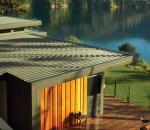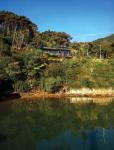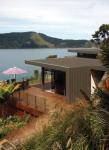Purotu Beach
Purotu Bach (Purotu - Maori means "Beautiful") dreamers nest at Bay of Many Coves Marlborough Sounds
Architect Davor Mikulcic admits he sometimes feels conflicted when asked to design a home that is going to sit in an area of natural beauty such as the Marlborough Sounds.
“To be honest, quite often at the start of the design process, after we have had a chance to talk to the client and experience the site for the first time, you ask yourself, ‘Should I do anything to the existing site, or should the beautiful natural environment remain as it is. For the project at the Bay of Many Coves this was not an issue.
The clients, when they introduced us to the project, already had on the site quite an old cottage which was not in very good condition.”
Davor says. “Overall the site actually combines two individual lots with total area of 4611sq m, with the building platform elevated about 10 meters above the sea level, at the lower level of the hilly site. The lovely positioned cottage was a single storeyed two-bedroom simple weatherboard finish and pitched ColorSteel-roofed dwelling and was nicely nestled into the surrounding native bush. The client very much loved it and was quite a difficult decision we did together to actually remove it from the site and design something new in its place. Emotionally it was a difficult decision, but it was a logical, more sustainable and cost effective solution, particularly with the knowledge of the remoteness of the site and the logistical requirements of any long-term maintenance.”
Building was also going to be more difficult than usual with Picton the closest town and the only access to the site being by boat (about a 40-minute trip) or helicopter. Most of the materials would have to be barged in.
“It is a tradition with Studio MWA’s Wellington and Brisbane offices to begin projects by spending time together with their clients, preferably on the future site. “There are many reasons for this, including to help us better understand the client’s needs, wants, preferences, requirements, any special spots and views and to visualize and experience the site’s constraints including access, orientation, context, services, topography and vegetation and any obstructions, or in simple wording the pluses and minuses we have to work with,” says Davor.
“Michael Maddern, our Wellington studio MWA practice Manager, and I had the amazing experience of spending one weekend with our clients on the future site in the old cottage and by talking, walking, eating, drinking, fishing, photographing, sketching, measuring we tried to live as the clients do to be as familiar as much as possible with the site and to try and understand our clients brief, which we developed even further.”
Driving the design of the 165sq m home was the client’s vision for a simple and functional dwelling - “the bach”.
They wanted an open plan kitchen/ dining/living area with a wood burner, three double bedrooms - all with a good orientation and view, a separate studio/office area, laundrychanging room after diving with exterior shower, main bathroom and a separate toilet. The outdoor space needed to incorporate the existing spa, which had to be strategically positioned to capture the view while remaining private. An outdoor shower in the same space was also a requirement.
Extensive decking was also needed to create outdoor areas all around the dwelling so the barbecue could be used in a variety of locations depending on conditions. A glass balustrade on the deck was a logical choice to preserve the stunning sea views.
Beginning the project in 2010, Studio MWA had free rein in the design process and used hand sketches, scale models, computer models and animations to give their clients a good feel for the design. Resource Consent was required because the position of the existing building and proposed building was inside the 8 metre setback from the protective 20 metre Queens Chain as per Department of Conservation requirements, and an excavation of more than 20 cubic metres of soil was required.
Davor says a lot of thought went into siting the new building so that it sat easily in the environment while capturing sun and views. “From the first initial sketches we did with our clients during our first site visit, it was obvious that we all had the same goal – to nicely settle the building in the existing environment, without competing or contrasting with the surroundings but to simply blend it into the natural environment.
After much discussion, the site of the old cottage was used but in a slightly different fashion. We rotated the new building to capture an even better orientation and view, we also decided that by pushing the building back into the hill our project will at the same time perform as a retaining wall to eliminate any future possible erosion while giving us the opportunity to sit even better the building into the site.
The solution was to stretch the buildings form along the existing contours, to capture the amazing view and take full advantage of the very good position and north east orientation.
“Through the building we created an internal street with a continual curved timber wall starting at the front of building flowing up from the timber deck on one side and finishing as a retaining wall on the other side of the building and curving 15 meters further, creating very intimate private courtyard with outdoor seating, spa and outdoor shower capturing the lovely sunsets at back and the stunning view to the front.”
Because of the home’s remoteness and coastal location using durable materials was of paramount importance.
“The main and the most dominant material on this project is definitely (together with grey tinted glass)
COLORSTEEL® MaxxTM metal roofing and wall cladding, by New Zealand Steel, helping to emphasise simplicity and elegant, clear, straight lines. The choice was a logical, easy and cost-effective solution for a low-maintenance material that performs very well in such a severe sea spray environment. The choice of
Paneldek profile by Steel and Tube, with hidden clip fixings without penetrations, further improves the visual appearance and long-term performance and maintenance of the roof and wall cladding. The Thunder Grey colour from the COLORSTEEL® MaxxTMcolour chart was quite an easy solution, gaining
inspiration from silvery grey colours of manuka and kanuka barks and natives surrounding building site.”
Having Sam Edwards and his team from Tory Channel Contracting as the main building contractors was a blessing, especially as they had the ability to see the job through from start to finish with a high level of craftsmanship. It also helped that the clients stayed on site serving as project managers and worked very hard to get the building delivered as well as doing extensive landscaping themselves.
Structurally, the bach is a singlestorey steel and timber framed structure with skillion roofs, seated at the front on timber piles and at the back on concrete slab with a 1 metre-high concrete retaining wall and footing along the entire length. The home is double-glazed and has exterior aluminium joinery.
Simple but robust materials such as stainless steel and lacquered marine ply feature in the kitchen, laundry and bathroom. Tasmanian oak floors provide a natural, warm look.
The fireplace was positioned in the centre of the building not only so it radiated heat evenly throughout but also to make it a congregation point.
On cold winter days or spring and autumn coldish nights it is the real “heart” of the bach and a centre place for memorable stories about diving, fishing and hunting, or dreaming about the past and about the future.
Studio MWA
Environmentally sustainable design is one of the firm’s main goals with a focus on thinking towards a better future. “We strongly believe that a sustainable approach and environmentally sensible designs are important ingredients in quality architecture and we are proud to incorporate it in every project. For many it is ‘fashion’ but for us it is essence in our everyday work.” To Studio MWA the principles such as the orientation of building, use of natural light, natural ventilation, use of passive solar energy, use of natural, recyclable and environmentally friendly materials and finishes (preferable local), effective sun protection, reduction of energy consumption, providing living and working comfort without sacrificing the environment of spaces, use of energy and water efficient systems, recycling and waste management, universal design principles - Lifemark - are all an integral part of our design discipline.





